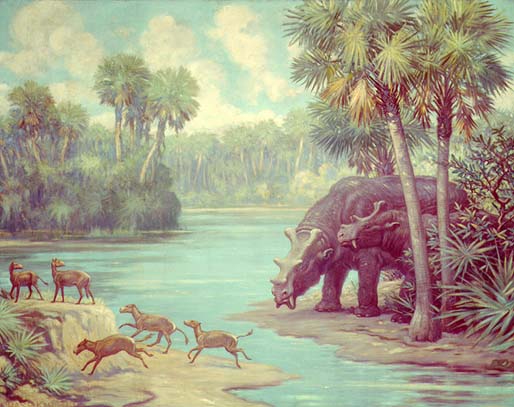 If I were more on the ball - or had an audience that I didn't think would be bored to tears by it - I would give a blow-by-blow overview of some of the research presented at the North American Paleontology Conference at the University of Cincinnati. There were several noteworthy talks, including a few session related to the public dissemination of paleontology, one of the most neglected and essential topics in any field of science. There were also several talks by friends of mine from Bristol and elsewhere in the world of paleontology, but rather than go into excruciating detail, if you really want to know about the talks at the meeting, I'll refer you to the abstract volume here. In general, it was a good conference, and certainly a change of pace from what I'm used to at the somewhat more formal annual meeting of the Society of Vertebrate Paleontology. It was also nice (and cheap!) to be put up in university which, while a bit on the institutional side, at least had an excellent view.Cincinnati was an interesting choice for a host city. I'd only ever been once before and remembered it being fairly unremarkable; that impression was borne out on this trip, but given that most people I know seem to actively dislike Cincinnati, I feel the need to stand up for it. It's true that the city has segregation issues, an apparent total lack of civic planning, and that Skyline Chili is not quite as great as it's made out to be. On the other hand, it has several things going for it. It has some really nice old neighborhoods, some gorgeous parks, a great zoo, and a baseball stadium right on the banks of the Ohio River.
If I were more on the ball - or had an audience that I didn't think would be bored to tears by it - I would give a blow-by-blow overview of some of the research presented at the North American Paleontology Conference at the University of Cincinnati. There were several noteworthy talks, including a few session related to the public dissemination of paleontology, one of the most neglected and essential topics in any field of science. There were also several talks by friends of mine from Bristol and elsewhere in the world of paleontology, but rather than go into excruciating detail, if you really want to know about the talks at the meeting, I'll refer you to the abstract volume here. In general, it was a good conference, and certainly a change of pace from what I'm used to at the somewhat more formal annual meeting of the Society of Vertebrate Paleontology. It was also nice (and cheap!) to be put up in university which, while a bit on the institutional side, at least had an excellent view.Cincinnati was an interesting choice for a host city. I'd only ever been once before and remembered it being fairly unremarkable; that impression was borne out on this trip, but given that most people I know seem to actively dislike Cincinnati, I feel the need to stand up for it. It's true that the city has segregation issues, an apparent total lack of civic planning, and that Skyline Chili is not quite as great as it's made out to be. On the other hand, it has several things going for it. It has some really nice old neighborhoods, some gorgeous parks, a great zoo, and a baseball stadium right on the banks of the Ohio River.The University of Cincinnati, where I spent most of my time, is one of the odder campuses out there, and like the city itself it inspires ambivalence. Much of the architecture on campus is very recent, and in some cases the results are very nice. However, in many cases the new building were constructed around the shells of older halls, which does nothing to dispel the university's odd vibe. Add to this some of the other unusual landscaping and architectural choices made by UC planners - the location of the football stadium directly in the middle of campus and the presence of dorms in the athletic center, for example - and you can see what I mean when I say it's a somewhat weird place. That said, I thought it was a pretty nice campus all in all; they've got a great music department, and I generally heard students practicing en route to the conference each day. There were lots of restaurants and shops around, as well as a couple of really good bars (one an outdoor beer garden, one an archetypal college pub, complete with shuffleboard). If campus itself got boring, there were some nice old neighborhoods and parks immediately to the north. The point of all this is that Cincinnati and its university probably don't deserve the negative reputation that seems to dog them. Neither may be the most exciting of its kind out there, but there are far worse places to find yourself on a sunny June day.




